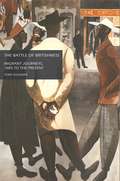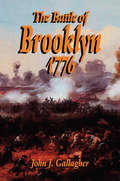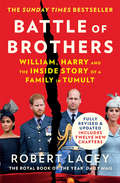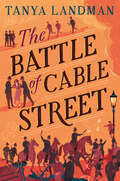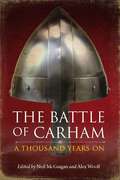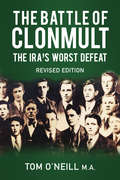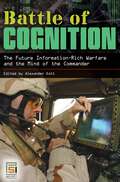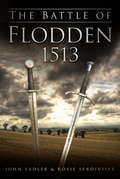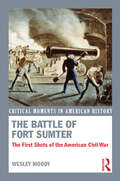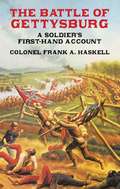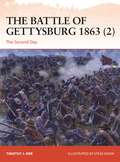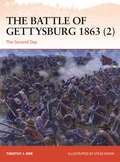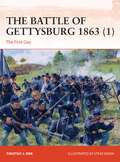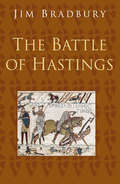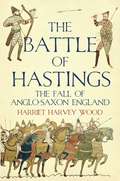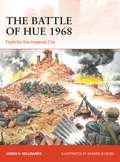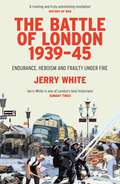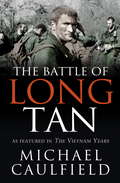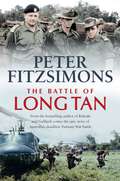- Table View
- List View
The battle of Britishness: Migrant journeys, 1685 to the present
by Tony KushnerAnalyzing the history and memory of migrant journeys, covering not only the response of politicians and the public but also literary and artistic representations, then and now, Kushner’s volume sheds new light on the nature and construction of Britishness from the early modern era onwards.
Battle Of Brooklyn 1776
by John J. GallagherIn Brooklyn, New York, for a few tense hours in 1776, the fate of the entire United States hung by a thread. The Battle of Brooklyn (sometimes called "The Battle of Long Island") has since come to be recognized as one of history's great battles.It was the largest clash of the Revolution, in terms of both troops and casualties, and it brought the fledgling American republic to the brink of disaster. At the height of the fighting, only the valiant sacrifice of one regiment--the Marylanders--staved off catastrophe. The British army, meanwhile, executed a three-pronged surprise assault with admirable professionalism, turning the wilds of Brooklyn into a killing ground for the British and Hessian troops.One can sympathize with the plight of George Washington, who, charged with the task of defeating the finest army of the Old World, had to mold citizen-soldiers from throughout the thirteen colonies--"patriots"--into a viable military force. At Brooklyn, the young American army did not quite meet its commander's expectations. Still, it remained in the field. And the evacuation conducted after the battle was a masterpiece of efficiency, ensuring that the New World's armed forces would fight another day.Thought the Battle of Brooklyn would prove a victory for the British Empire, it demonstrated to all the American resolve and courage that would eventually result in independence for the United States."In his shot-by-shot account of the largest and bloodiest battle of the American Revolution, Gallagher recreates the fierce encounter of 27 August 1776 in which twenty thousand British, Hessian and Loyalist troops defeated ten thousand patriot soldiers. . . . the book offers many perceptive observations and the author succinctly summarizes the lessons derived . . . this book is recommended reading for those who cherish the heritage of the gallant 'rabble in arms' that risked all for American independence."-Long Island Historical Journal"Long neglected . . . the Battle of Brooklyn is given comprehensive coverage . . . using a lively writing style Gallagher makes it easy to visualize the actual skirmishes by providing interesting details." -Flintlock and Powderhorn
Battle Of Brooklyn 1776
by John J. GallagherIn Brooklyn, New York, for a few tense hours in 1776, the fate of the entire United States hung by a thread. The Battle of Brooklyn (sometimes called "The Battle of Long Island") has since come to be recognized as one of history's great battles.It was the largest clash of the Revolution, in terms of both troops and casualties, and it brought the fledgling American republic to the brink of disaster. At the height of the fighting, only the valiant sacrifice of one regiment--the Marylanders--staved off catastrophe. The British army, meanwhile, executed a three-pronged surprise assault with admirable professionalism, turning the wilds of Brooklyn into a killing ground for the British and Hessian troops.One can sympathize with the plight of George Washington, who, charged with the task of defeating the finest army of the Old World, had to mold citizen-soldiers from throughout the thirteen colonies--"patriots"--into a viable military force. At Brooklyn, the young American army did not quite meet its commander's expectations. Still, it remained in the field. And the evacuation conducted after the battle was a masterpiece of efficiency, ensuring that the New World's armed forces would fight another day.Thought the Battle of Brooklyn would prove a victory for the British Empire, it demonstrated to all the American resolve and courage that would eventually result in independence for the United States."In his shot-by-shot account of the largest and bloodiest battle of the American Revolution, Gallagher recreates the fierce encounter of 27 August 1776 in which twenty thousand British, Hessian and Loyalist troops defeated ten thousand patriot soldiers. . . . the book offers many perceptive observations and the author succinctly summarizes the lessons derived . . . this book is recommended reading for those who cherish the heritage of the gallant 'rabble in arms' that risked all for American independence."-Long Island Historical Journal"Long neglected . . . the Battle of Brooklyn is given comprehensive coverage . . . using a lively writing style Gallagher makes it easy to visualize the actual skirmishes by providing interesting details." -Flintlock and Powderhorn
Battle of Brothers: William, Harry And The Inside Story Of A Family In Tumult
by Robert Lacey‘THE ROYAL BOOK OF THE YEAR … You’ve read their side of the story, now read the real story’ Daily Mail THIS CRISIS IS AS BIG AS THE ABDICATION – SAYS LACEY, HISTORICAL ADVISOR TO THE CROWN.
The Battle of Cable Street
by Tanya LandmanPolitical tensions are heightening on the streets of Stepney, and as Oswald Mosley comes to power, Elsie begins to see friendships torn apart … Award-winning author Tanya Landman explores the rise of antisemitic fascism in 1930s London in this gripping new story.
The Battle of Carham: A Thousand Years On
by Neil McGuigan and Alex WoolfVery little is known about the battle of Carham, fought between the Scots and Northumbrians in 1018. The leaders were probably Máel Coluim II, king of Scotland, and Uhtred of Bamburgh, earl or ealdorman in Northumbria. The outcome of the battle was a victory for the Scots, seen by some as a pivotal event in the expansion of the Scottish kingdom, the demise of Northumbria and the Scottish conquest of ‘Lothian’. The battle also removed a potentially significant source of resistance to the recent conqueror of England, Cnut.This collection of essays by a range of subject specialists explores the battle in its context, bringing new understanding of this important and controversial historical event. Topics covered include: Anglo-Scottish relations, the political character and ecclesiastical organisation of the Northumbrian territory ruled by Uhtred, material from the Chronicles and other historical records that brings the era to light, and the archaeological and sculptural landscape of the tenth- and eleventh-century Tweed basin, where the battle took place.
The Battle of Clonmult: The IRA's Worst Defeat
by Tom O'NeillExhaustive research by the author of newly available primary source material has unearthed new facts surrounding the battle. The new information allows this edition to more accurately document and analyse the Battle of Clonmult. The book makes an enormous contribution to our understanding of the events surrounding this battle and of the manner in which both sides conducted their military operations during the War of Independence. New insight revealed by the author’s research into the details of military operations by both sides is applicable not just to East Cork, but nationally. The information and analysis provided is timely as it increases our awareness of a period in our history which we are currently preparing to recognise and commemorate over the next few years.
Battle of Cognition: The Future Information-Rich Warfare and the Mind of the Commander (Praeger Security International)
by Alexander KottWhat if the true weak link of the Information Age force is not the hardware of machines, but the software of the human mind? And if so, could it be that the entire conceptual structure of the Information Revolution theorists, at least as it applies to military affairs, is built on sand, on the notorious fickleness of human cognition? These are the questions this book strives to examine. Looking at the command and control of information-rich warfare, the contributors explore its potential new processes, techniques, and organizational structures. As they do so, they find reasons for both optimism and concerns about the limitations of human cognition and supporting technologies in commanding battles in the Information Age.Since the beginning of the Information Revolution, the military in the United States and elsewhere has been analyzing and implementing the changes driven by the rapidly advancing information technologies. Among military theorists and practitioners, many focus on the Information Revolution's impact on matters of military equipment. Far fewer, however, seem to worry about the gray matter—the mind of the commander, the place where all the information power of the new age is supposed to converge and to yield its mighty dividends.Consider that it is the human mind, particularly the minds of military commanders and their staffs that remain the pinnacle and the ultimate consumer of the rapidly growing information flows. What if the true weak link of the Information Age force is not the hardware of machines, but the software of the human mind? And if so, could it be that the entire conceptual structure of the Information Revolution theorists, at least as it applies to military affairs, is built on sand, on the notorious fickleness of human cognition? These are the questions this book strives to examine. Looking at the command and control of information-rich warfare, the authors explore its potential new processes, techniques, and organizational structures. As they do so, they find reasons for both optimism and concerns about the limitations of human cognition and supporting technologies in commanding Information Age battles.
The Battle of Crécy: A Casebook (Liverpool Historical Casebooks)
by Michael Livingston Kelly De VriesWinner of the Society for Military History Distinguished Book Award 2017This casebook is the most extensive collection of documents ever assembled for the study of one of the famous battles in history. Here we see the Battle of Crécy across the cultural landscape of Europe — through chronicles and letters, through poems and prophecies, through sermons and laments — enabling us to understand the events of 26 August 1346 like never before. Together with other experts, the editors have gathered, edited, and translated over 80 fourteenth-century sources concerning this fascinating and important conflict — sources from Bohemia to France, from Italy to Wales — many here printed or translated for the first time. Original essays provide historical context and literary background to help interpret the battle in light of this new material. Among the discoveries: despite its fame, the location of the battle has been misidentified for centuries, and the actions of the men on both sides of the bloodied field have been completely misunderstood. This unparalleled accumulation of material means that the Battle of Crécy will never be seen in the same way again.
The Battle of Ezra Church and the Struggle for Atlanta (Civil War America)
by Earl J. HessFought on July 28, 1864, the Battle of Ezra Church was a dramatic engagement during the Civil War's Atlanta campaign. Confederate forces under John Bell Hood desperately fought to stop William T. Sherman's advancing armies as they tried to cut the last Confederate supply line into the city. Confederates under General Stephen D. Lee nearly overwhelmed the Union right flank, but Federals under General Oliver O. Howard decisively repelled every attack. After five hours of struggle, 5,000 Confederates lay dead and wounded, while only 632 Federals were lost. The result was another major step in Sherman's long effort to take Atlanta.Hess's compelling study is the first book-length account of the fighting at Ezra Church. Detailing Lee's tactical missteps and Howard's vigilant leadership, he challenges many common misconceptions about the battle. Richly narrated and drawn from an array of unpublished manuscripts and firsthand accounts, Hess's work sheds new light on the complexities and significance of this important engagement, both on and off the battlefield.
The Battle of Flodden 1513
by John Sadler Rosie SerdivilleThe Battle of Flodden in 1513 was the largest battle ever to take place between England and Scotland. James IV himself led an army of 30,000 men over the border into England, ostensibly in revenge for the murder of a Scotsman, but in reality to assist their ally the French by diverting the forces of Henry VIII. Yet the Scots were hampered by old-fashioned weapons and tactics, whereas the English deployed more accurate artillery and their vaunted longbowmen. When King James IV was killed while leading a charge, and many of their officers died, the Scots were left in disarray and the English victory was decisive. As the first new history of the battle in a decade, this authoritative and eye-opening account marks the 500th anniversary and brings our knowledge of the conflict up to date. Expert knowledge and detailed maps look at the key events, the 1135 campaign and the minor battles of Millfield and Norham, and a full profile of the respective forces and deployments, and convey the battle’s course concisely and clearly. A key read for those interested in military history or the period in general.
The Battle of Fort Sumter: The First Shots of the American Civil War (Critical Moments in American History)
by Wesley MoodyOn April 12, 1861, the long-simmering tensions between the American North and South exploded as Southern troops in the seceding state of South Carolina fired on the Federal forces at Fort Sumter in Charleston harbor. The battle of Fort Sumter marked the outbreak of Civil War in the United States. The attack provoked outrage in the North, consolidated support for the newly inaugurated President Lincoln, and fueled the onset of the war that would consume and reshape the country. In this concise narrative, Wesley Moody explores the long history of tensions that lead to the events at Fort Sumter, the details of the crisis and battle, the impact of Fort Sumter on the unfolding Civil War, and the battle's place in historical memory. Supplemented by primary documents including newspaper coverage, first-person accounts, letters, and government documents, and supported by a companion website, this book provides students with a nuanced understanding of both the long-term and immediate origins of the American Civil War.
The Battle of Fort Sumter: The First Shots of the American Civil War (Critical Moments in American History)
by Wesley MoodyOn April 12, 1861, the long-simmering tensions between the American North and South exploded as Southern troops in the seceding state of South Carolina fired on the Federal forces at Fort Sumter in Charleston harbor. The battle of Fort Sumter marked the outbreak of Civil War in the United States. The attack provoked outrage in the North, consolidated support for the newly inaugurated President Lincoln, and fueled the onset of the war that would consume and reshape the country. In this concise narrative, Wesley Moody explores the long history of tensions that lead to the events at Fort Sumter, the details of the crisis and battle, the impact of Fort Sumter on the unfolding Civil War, and the battle's place in historical memory. Supplemented by primary documents including newspaper coverage, first-person accounts, letters, and government documents, and supported by a companion website, this book provides students with a nuanced understanding of both the long-term and immediate origins of the American Civil War.
The Battle of Gettysburg: A Soldier's First-Hand Account (Civil War)
by Frank A. HaskelThe bloody, three-day battle of Gettysburg in the summer of 1863 resulted in thousands of casualties on both sides. Considered the turning point of the Civil War, the campaign rallied the Union troops. A few weeks after the epic military confrontation, Colonel Frank Haskell, a member of the Army of the Potomac, wrote his brother in Wisconsin a highly moving account of what he had experienced. It was perhaps the longest, most poignant letter to a relative from a soldier in the Civil War. Some 45 years later, his comments appeared in book format; this volume is a reprint of that rare edition. In this keenly observed narration, Haskell vividly describes each day's events and what they wrought: the wounded, the skirmishes, attacks and counterattacks, estimates of losses, marks of battle, and burial of the dead. Of the crests in Gettysburg known as Cemetery Ridge, he writes: "Men looked like giants there in the mist, and the guns of the frowning batteries so big, that it was a relief to know that they were our friends." On the second day of battle, he lost his horse "Billy" to a bullet that just missed Haskell's left leg. Mentally, he "begged [Billy's] pardon for spurring him." On the last day, he notes: "The Rebel guns make no reply to ours, no charging shout rings out to-day . . . the jostling, swaying lines on either side boil, and roar, and dash their flamy spray, two hostile billows of a fiery ocean. . . . The frequent dead and wounded lie where they stagger and fall . . . and none can be spared to care for them." He helped bury the dead that day and ended his letter on a note of hope, speaking of a future in which the Union would "repose in a securer peace and bloom in a higher civilization." Almost a year later — on June 3, 1864, at Cold Harbor, Virginia — Colonel Haskell was killed in action. He was 36 years old. One of the war's best eyewitness accounts, this classic narrative, required reading for students of American history, will be treasured by Civil War buffs.
The Battle of Gettysburg 1863: The Second Day (Campaign)
by Timothy OrrThis work provides an authoritative illustrated examination of the second day of the Battle of Gettysburg, analyzing both grand strategy, and the tactical decisions of Day Two and the ensuing combat.July 2, 1863 was the bloodiest and most complicated of the three days of the Battle of Gettysburg. On this day, the clash involved five divisions of Confederate infantry and their accompanying artillery battalions, as well as a cavalry skirmish at nearby Hunterstown. The bulk of the Union army engaged on the second day of fighting, including men from the 2nd, 3rd, 5th, 6th, 11th and 12th Corps.Assisted by superb maps and 3D diagrams, this fascinating work describes the tactical play-by-play, the customary “who did what” of the battle. Among the famous actions covered are Hunterstown and Benner's Hill, Little Round Top, Devil's Den, the Rose Wheatfield, the Peach Orchard, and Culp's and Cemetery hills. The critical decisions taken on the second day are examined in detail, and why the commanders committed to them. Gettysburg was-first and foremost-a soldier's battle, full of raw emotion and high drama, and this work also examines the experience of combat as witnessed by the rank and file, bringing this to life in stunning battlescene artworks and primary accounts from common soldiers.
The Battle of Gettysburg 1863: The Second Day (Campaign)
by Timothy OrrThis work provides an authoritative illustrated examination of the second day of the Battle of Gettysburg, analyzing both grand strategy, and the tactical decisions of Day Two and the ensuing combat.July 2, 1863 was the bloodiest and most complicated of the three days of the Battle of Gettysburg. On this day, the clash involved five divisions of Confederate infantry and their accompanying artillery battalions, as well as a cavalry skirmish at nearby Hunterstown. The bulk of the Union army engaged on the second day of fighting, including men from the 2nd, 3rd, 5th, 6th, 11th and 12th Corps.Assisted by superb maps and 3D diagrams, this fascinating work describes the tactical play-by-play, the customary “who did what” of the battle. Among the famous actions covered are Hunterstown and Benner's Hill, Little Round Top, Devil's Den, the Rose Wheatfield, the Peach Orchard, and Culp's and Cemetery hills. The critical decisions taken on the second day are examined in detail, and why the commanders committed to them. Gettysburg was-first and foremost-a soldier's battle, full of raw emotion and high drama, and this work also examines the experience of combat as witnessed by the rank and file, bringing this to life in stunning battlescene artworks and primary accounts from common soldiers.
The Battle of Gettysburg 1863: The First Day (Campaign)
by Timothy J. OrrThis first volume of three discusses the tactical decisions made on day one and the ensuing combat, while also including a brief summary of the grand strategy in the Eastern Theater of the war, the conduct of the Pennsylvania Campaign from June 6 to 30, 1863, and the plight of civilians caught up in the conflict.The Battle of Gettysburg, which took place July 1–3, 1863 in and around the town of Gettysburg, PA resulted in the largest number of casualties of the entire American Civil War and is seen as the key turning point in the conflict. On its first day, Confederate General Robert E. Lee's Army of Northern Virginia sought to destroy the Union army, forcing its men to retreat through the streets of the Pennsylvania town to the hills just to the south. This volume, the first of three to cover the battle in depth, includes the morning cavalry skirmish, the morning clash at the Herbst's Woodlot and at the railroad cut, the afternoon clash at Oak Ridge, the afternoon fight at the Edward McPherson farm, the afternoon rout of the 11th Corps, the last stand of the 1st Corps at Seminary Ridge, the Union retreat through town, and the positions of the armies at nightfall.
The Battle of Hastings (Military History Ser.)
by Jim BradburyThe Battle of Hastings is probably the best-known and perhaps the most significant battle in English history. Its effects were deeply felt at the time, causing a lasting shift in cultural identity and national pride. Jim Bradbury here explores the full military background to the battle and investigates both the sources for our knowledge of what actually happened in 1066 and the role that the battle plays in national myth. The Battle of Hastings starts by looking at the Normans - who they were, where they came from - and the career of William before 1066. Next, Jim Bradbury turns to the Saxons in England, and to Harold Godwineson, successor to Edward the Confessor, and his attempts to create unity in the divided kingdom. This provides the background to an examination of the military development of the two sides up to 1066, detailing differences in tactics, arms and armour. The core of the book is a move-by-move reconstruction of the battle, including the advance planning, the site, the composition of the two armies and the use of archers, feigned flights and the death of Harold. This is a book that anyone interested in England's most famous battle will find indispensable.
The Battle of Hastings: The Fall of Anglo-Saxon England
by Harriet Harvey WoodHarriet Harvey Wood's original and fascinating book shows that, rather than bringing culture and enlightenment to England, the Normans' aggressive and illegal invasion destroyed a long-established and highly-developed civilization which was far ahead of other European peoples in its political institutions, art and literature. It explores the background and lead-up to the invasion and the motives of the leading players, the state of warfare in England and Normandy in 1066, and the battle itself.By all the laws of probability, King Harold ought to have won the battle of Hastings without difficulty and to have enjoyed a peaceful and enlightened reign. That he did not was largely a matter of sheer bad luck. The result could just as easily have gone the other way. This gripping and highly-readable book shows how he came to be defeated, and what England lost as a result of his defeat and death.
The Battle of Hue 1968: Fight for the Imperial City (Campaign)
by James H WillbanksIn late January 1968, some 84,000 North Vietnamese and Viet Cong troops launched a country-wide general offensive in South Vietnam, mounting simultaneous assaults on 36 of 44 provincial capitals, and five of the six autonomous cities (including the capital city of Saigon). The longest and bloodiest battle occurred in Hue, the most venerated place in Vietnam. The bitter fighting that raged there for more than three weeks drew the attention of the world.Hue was the ancient capital of Vietnam, and as such, had been previously avoided by both sides; it had not seen any serious fighting prior to 1968. All that changed on the night of January 31 that year when four North Vietnamese battalions and supporting Viet Cong units simultaneously attacked and occupied both parts of the city straddling the Perfume River. The Communist forces dug in and prepared to defend their hold on the city. US Marines and South Vietnamese soldiers were ordered to clear the city, supported by US Army artillery and troops. A brutal urban battle ensued as combat raged from house to house and door to door. It was a bloody fight and resulted in large-scale destruction of Hue. Eventually, the Marines and the South Vietnamese forces retook Hue, but it turned out to be one of the longest and bloodiest battles of the Tet Offensive, and led to a sea change in US policy in Vietnam.
The Battle of Hue 1968: Fight for the Imperial City (Campaign)
by James H WillbanksIn late January 1968, some 84,000 North Vietnamese and Viet Cong troops launched a country-wide general offensive in South Vietnam, mounting simultaneous assaults on 36 of 44 provincial capitals, and five of the six autonomous cities (including the capital city of Saigon). The longest and bloodiest battle occurred in Hue, the most venerated place in Vietnam. The bitter fighting that raged there for more than three weeks drew the attention of the world.Hue was the ancient capital of Vietnam, and as such, had been previously avoided by both sides; it had not seen any serious fighting prior to 1968. All that changed on the night of January 31 that year when four North Vietnamese battalions and supporting Viet Cong units simultaneously attacked and occupied both parts of the city straddling the Perfume River. The Communist forces dug in and prepared to defend their hold on the city. US Marines and South Vietnamese soldiers were ordered to clear the city, supported by US Army artillery and troops. A brutal urban battle ensued as combat raged from house to house and door to door. It was a bloody fight and resulted in large-scale destruction of Hue. Eventually, the Marines and the South Vietnamese forces retook Hue, but it turned out to be one of the longest and bloodiest battles of the Tet Offensive, and led to a sea change in US policy in Vietnam.
The Battle of Kursk: Hitler’s last gamble in the East (Under Fire)
by Georgia BallIn 1943, the fate of the Eastern Front hung in the balance. After a crushing defeat at Stalingrad, the German Army, desperate to regain the initiative, planned a huge offensive near the city of Kursk, 280 miles south-west of Moscow. Armed with the new Panther and Tiger tanks, Hitler and Field Marshal Erich von Manstein hoped to cut off and destroy Soviet forces in the Kursk salient using a pincer attack. But the Soviets knew they were coming, and they were ready. The elite SS Panzer divisions were flung headlong into a well-prepared Soviet defence, and a bitter battle ensued. This graphic novel brings that battle vividly to life through the eyes of the men who were there, combining historical authenticity with stunning illustrations to tell the full story of the last great German offensive on the Eastern Front.
The Battle of London 1939-45: Endurance, Heroism and Frailty Under Fire
by Jerry WhiteThe definitive social history of London in the Blitz, which transformed life in the capital beyond recognition.For Londoners the six long years of the Second World War were a time of almost constant anxiety, disruption, deprivation and sacrifice. The Blitz began in earnest in September 1940 and from then on, for prolonged periods, London was under sustained aerial bombardment by night and by day. Throughout the war, the capital was the nation's front line; by its end, 30,000 Londoners had lost their lives.Yet if the bombing defined the era for those who lived through it, the months of terror were outnumbered by those spent knitting together the fabric of daily life at work, in the home, on the allotment, in the cinema or theatre and, not least, standing in those interminable queues for daily necessities that were such a feature of London's war. Much has been written about 'the Myth of the Blitz' but in this riveting social history, Jerry White has unearthed what actually happened during those tempestuous years, getting close up to the daily lives of ordinary people, telling the story through their own voices. At the end of it all, the Battle of London was won not on the playing fields of Eton but in the playgrounds of a thousand council elementary schools across the capital.
The Battle of Long Tan: As featured in The Vietnam Years
by Michael CaulfieldThe truth about the battle that came to define our Vietnam War - from the men who were there.18th August, 1966. 1pm…D Company entered the plantation. They thought that, if they were lucky, they were closing in on perhaps 30 or 40 VC. They were horribly wrong.Over twelve long, bloody and brutal hours, 105 Australian soldiers and three New Zealanders fought off mortar attacks and heavy machine-gun fire, unaware they were facing up to 2500 Viet Cong and North Vietnamese forces. The first major battle of the war for the Australians, our men showed extraordinary courage and, against all odds, they triumphed – although the Vietnamese didn't admit this for another forty years.In The Battle of Long Tan, Caulfield takes us through that hellish day in the Long Tan rubber plantation, combining gripping first-hand accounts from eleven of the men who fought with an authoritative overview of the battle itself – from headquarters to the men in the field.This is as close as you'll get to being there.Michael Caulfield has worked as a composer, musician, TV and film producer, and director. He was the executive producer of the ABC TV series Australians at War. His books with Hachette Australia include The Vietnam Years, War behind the Wire and Voices of War.
The Battle of Long Tan
by Peter FitzSimonsFrom the bestselling author of Kokoda and Gallipoli comes the epic story of Australia's deadliest Vietnam War battle.4.31 pm: Enemy [on] left flank. Could be serious.5.01 pm: Enemy ... penetrating both flanks and to north and south.5.02: Running short of ammo. Require drop through trees.It was the afternoon of 18 August 1966, hot, humid with grey monsoonal skies. D Company, 6RAR were four kilometres east of their Nui Dat base, on patrol in a rubber plantation not far from the abandoned village of Long Tan. A day after their base had suffered a mortar strike, they were looking for Viet Cong soldiers. Then - just when they were least expecting - they found them. Under withering fire, some Diggers perished, some were grievously wounded, the rest fought on, as they remained under sustained attack.For hours these men fought for their lives against the enemy onslaught. The skies opened and the rain fell as ferocious mortar and automatic fire pinned them down. Snipers shot at close quarters from the trees that surrounded them. The Aussie, Kiwi and Yankee artillery batteries knew it was up to them but, outnumbered and running out of ammunition they fired, loaded, fired as Viet Cong and North Vietnamese Army forces just kept coming. And coming.Their only hope was if Armoured Personnel Carriers (APCs) could reach them before they were wiped out. The APCs did their best but low cloud and thunderstorms meant air support was stalled. A daring helicopter resupply mission was suggested but who would want to fly that? The odds against this small force were monumental...By far the deadliest battle for Australian forces in Vietnam, the Battle of Long Tan has a proud place in the annals of Australian military history - and every ANZAC who fought there could hold his head high.Peter FitzSimons, Australia's greatest storyteller, tells the real story of this classic battle. He reveals the horror, the bravery, the wins and the losses that faced our soldiers. He brings to life the personal stories of the men who fought, the events leading up to that memorable battle and the long war that followed, and the political decisions made in the halls of power that sealed their fates. The Battle of Long Tan is an engrossing and powerful history that shows the costs of war never end.
